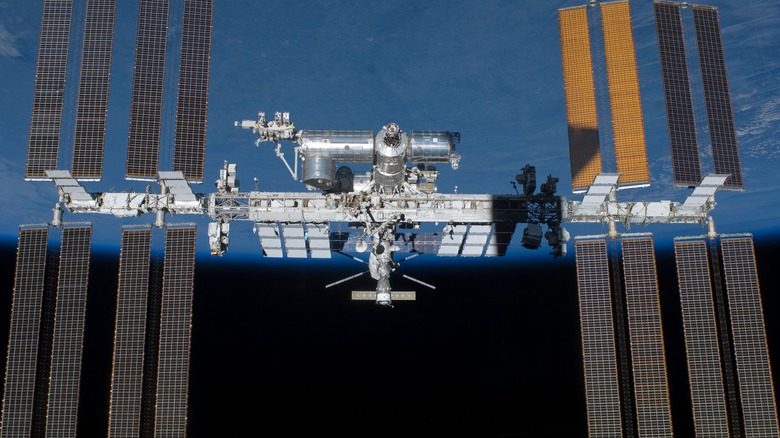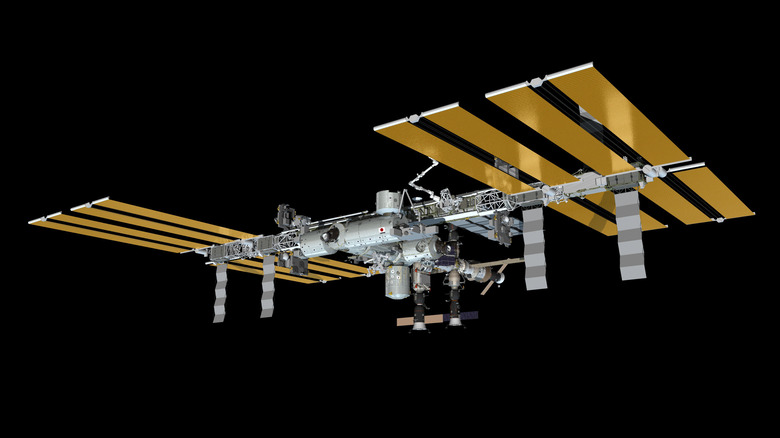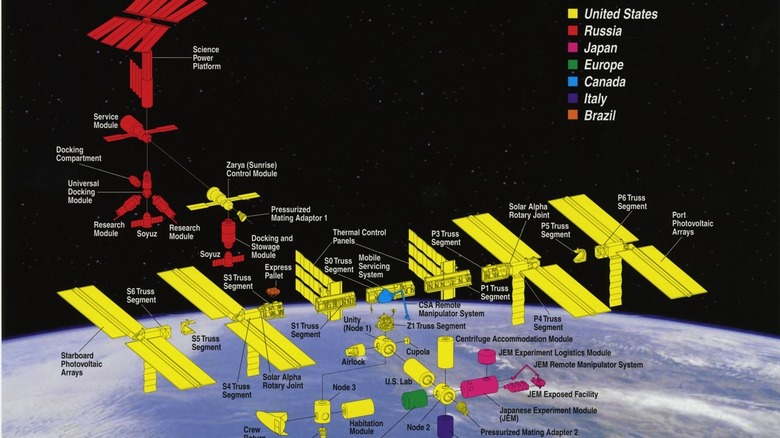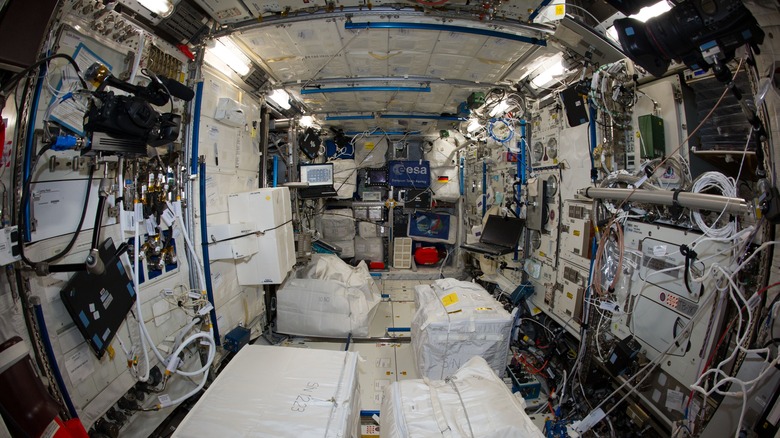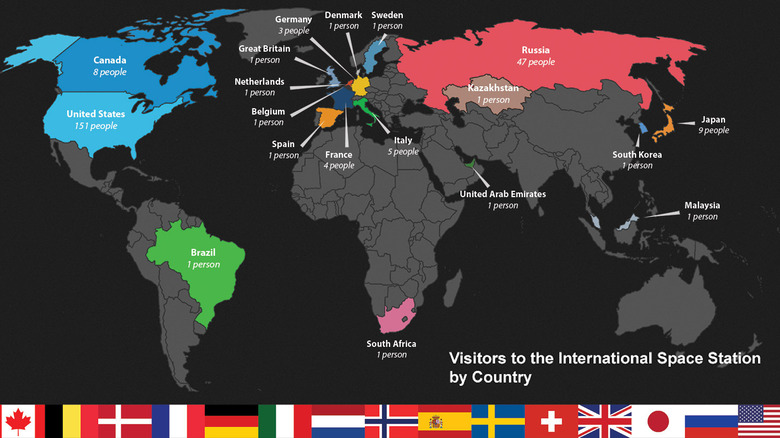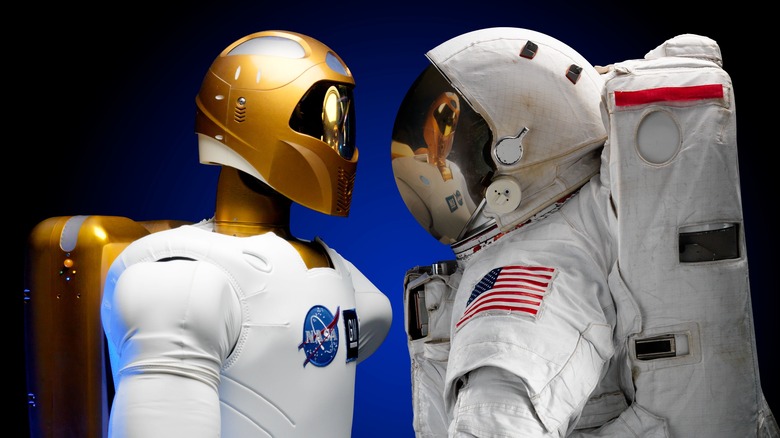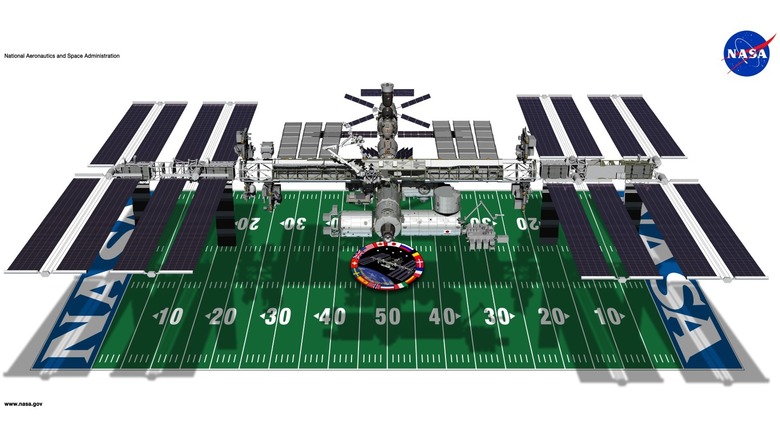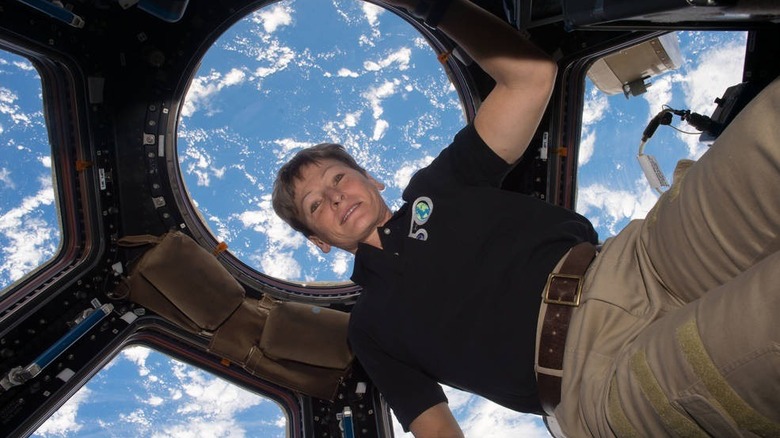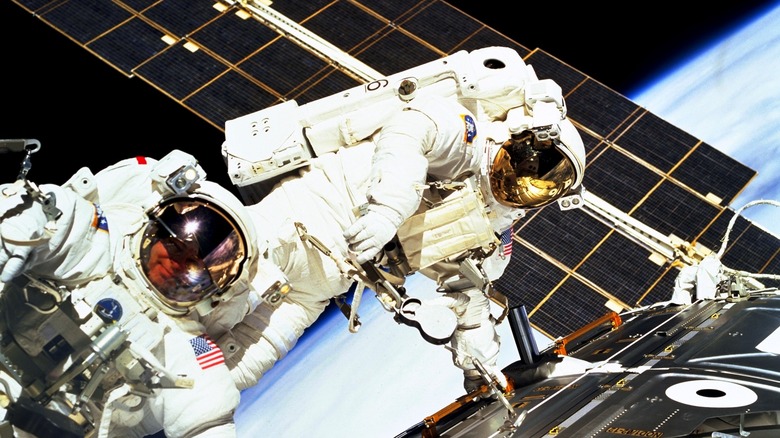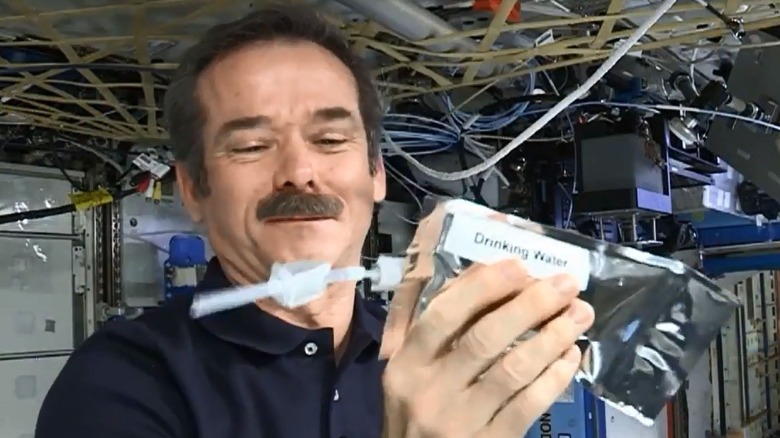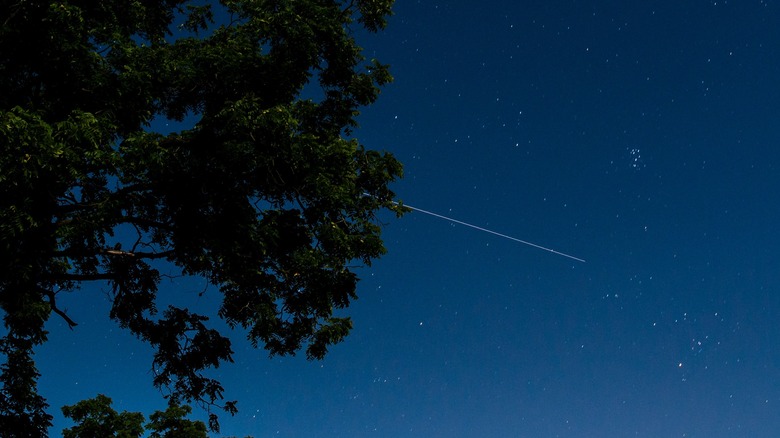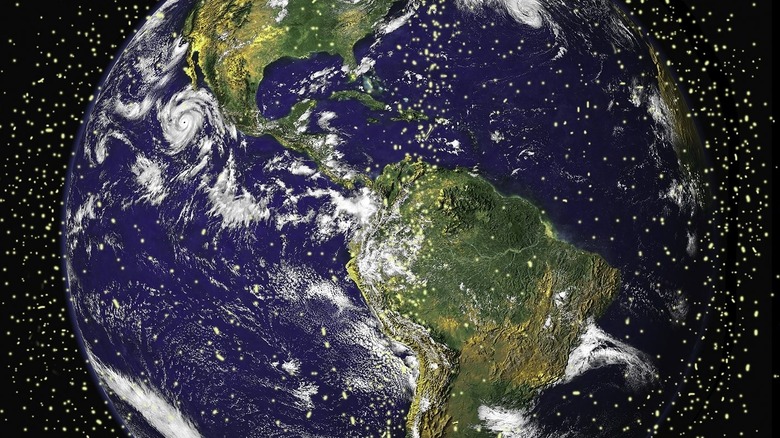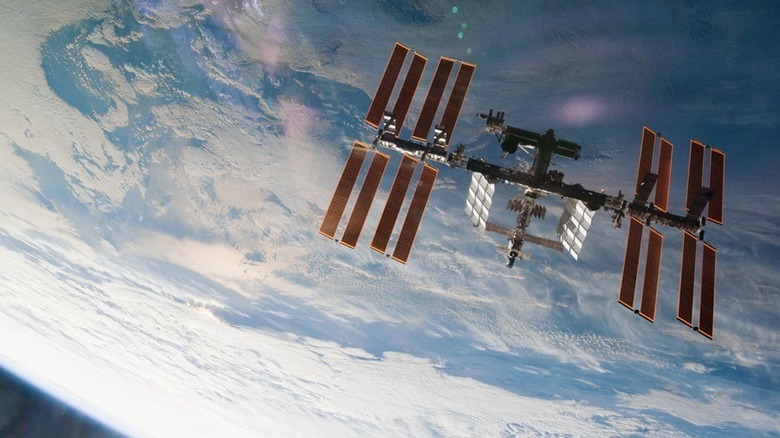13 Interesting Facts About The International Space Station
Before the space race even properly began, experts were already making plans for orbiting space stations where people could live and work. Those goals initially took a back seat as the Soviet Union and the United States raced for a crewed moon landing.
Once humanity had boots on the lunar surface, the focus shifted to establishing a more permanent human presence in space. The first proper space station, Salyut 1, was constructed by the Soviet Union in 1971. Additional stations were launched during the rest of the Salyut program over the next 15 years.
In 1986, the Soviet Union launched Mir which, unlike the previous comparatively simple stations, was modular, allowing additions over time. This station set the stage for what would become the most impressive construction project in human history.
Beginning in 1998, the Soviet Union and the United States embarked on a joint project to build a massive orbiting laboratory in low Earth orbit. With the joining of the first two modules, Zarya and Unity, the International Space Station was born. Its creation has allowed a constant human presence in space for more than 20 years and provided a base of operations for experimentation in microgravity and the study of spaceflight's impact on the human body.
The ISS is laying the groundwork for future long-term missions to Mars and beyond while remaining the single coolest thing we've ever built. Here's why.
It travels really fast
The ISS isn't the fastest thing humans have ever built — that honor goes to the Parker Solar Probe, which travels around the sun and Venus at 430,000 miles per hour. Still, the International Space Station orbits at an incredible rate.
The station orbits the Earth at about 17,500 miles per hour. At that speed, astronauts onboard circle the Earth once every 90 minutes, experiencing a sunrise and sunset 16 times in every 24-hour period. While the astronauts and cosmonauts may not feel it while they're at work on the station, this means they're crossing five miles of space terrain every single second. That's approximately 23 times the speed of sound.
For context, the distance from the Earth to the moon is roughly 238,900 miles. Apollo 11 astronauts took roughly three days to get there in 1969, but at the rate the space station is traveling, it could get to the moon and back to Earth in just about a day.
People on the space station experience time more slowly
Relativity tells us that the faster we're moving, the slower we experience time. Over the course of our ordinary lives, we don't travel at rates that change our subjective experience of time in a substantial way, but things are different when you're moving really fast. As we approach the speed of light, if we ever figure out how to do that, the change in subjective time would make a real difference.
Despite its speed, the International Space Station is still moving relatively slowly compared to the incredible 186,000 miles per second that light travels. Still, the ISS is moving quickly enough to measure the effects of time dilation on its inhabitants.
An astronaut or cosmonaut who lives a year on the space station will experience roughly one-hundredth of a second less than those of us on the surface of the Earth. It's not much, but it still means the people on the station are, compared to the rest of us, very slowly time-traveling into the future.
It was built by five space agencies and 15 total countries
Space exploration often feels like a competition between various nations, but the International Space Station challenges that attitude. Space is, by definition, a domain that exists without borders and it represents an opportunity for the global community to operate in concert, rather than in opposition.
When the station was first being built, the United States and Russia were the only two partner nations, but in the intervening years, more nations and organizations have joined the party. Today, the International Space Station has been built and crewed by NASA, Russia's Roscosmos, the Canadian Space Agency (CSA), the Japan Aerospace Exploration Agency (JAXA), and the European Space Agency (ESA), which is comprised of 11 countries.
Crew space on the ISS is allocated based on the relative contribution of each nation or organization to the whole. To date, the station has seen crew and visitors from 18 countries including each of the member nations and a few others. The station stands as a continuing symbol of what's possible when humanity works together without borders and across political ideologies.
The legal status on the station is...complicated
The law of the land, so to speak, on the ISS is the International Space Station Intergovernmental Agreement (IGA) which was signed in January 1998. Because the station is jointly owned and operated by various government entities, the legalities onboard the ship get a little wild.
The agreement lays out ownership and jurisdiction of the station's various components. In the simplest terms, the member nations are able to extend their legal jurisdiction to the portions of the station (modules or equipment) which they provided, as well as to the crew members they send.
That means it's possible an astronaut might be subject to the laws of the United States in one room, and those of Japan, Russia, Canada, or Europe in the next. This could result in a tangled web of expectations for people to navigate on the station, but things are simplified by an interparty waiver of liability. The agreement essentially states none of the member nation will hold any of the other partners liable for incidents or damage as a result of normal station activities. Additionally, any claims which do arise are handled under agreement among the partner nations.
Luckily, space travelers tend to avoid committing crimes while off planet. When crimes do occur, as was the case in 2019 when an astronaut allegedly illegally accessed their partner's bank account from the station, the IGA provides a framework for how to address them.
The station has hosted more than 250 astronauts
At any given time, the space station typically has a crew of seven people aboard the ISS. There are times, particularly during crew changeovers, when up to 13 crew members might temporarily be aboard, but those times are few and short-lived.
Because the station has been continuously inhabited for more than two decades, many people have come and gone. As of February 2022, 251 people have visited the station, hailing from 19 countries. As previously stated, crew assignments are based largely on a country's contribution to the station. Consequently, a majority of the station's crew, 155 astronauts, have come from the United States.
A further 52 were Russian cosmonauts, 11 were Japanese astronauts, 8 were astronauts from Canada including Chris Hadfield who commanded the station, and five or fewer came from various members of the European Space Agency or visiting nations. At current, the record for most visits to the station is jointly held by Yuri Malenchenko and Fyodor Yurchikhin, both of whom have traveled to the ISS five times.
The ISS has a robot crew member
The ISS wouldn't be a proper spaceship if it didn't also have a robot crew member. In an effort to make good on our fantasies of robot space companions like Lieutenant Commander Data and the simply named Robot from "Lost in Space," scientists at NASA's Johnson Space Center (JSC) crafted Robonaut 2 as the first synthetic member of the station's crew.
Commonly called R2—which gives us Luke Skywalker vibes—Robonaut has lived aboard the ISS since 2012. R2 has vision systems, sensors, and hands that are nearly identical to that of humans in dexterity. The robot is capable of completing repetitive or dangerous tasks on behalf of the crew, freeing them up to do critical work or preventing them from encountering potential harm.
However, Robonaut 2 is mostly used in-station as a testbed for future robotic activities on long-term space missions. What the crew learns about Robonaut's abilities could lead to even more advanced robots assisting astronauts on Mars missions.
Including solar arrays, the station is roughly the size of a football field
The International Space Station is the largest spacecraft ever constructed by a pretty wide margin. If we were to lay it on the ground, the ISS would stretch across an entire football field side to side and end to end.
At 357 feet in length, and with a weight of nearly 1 million pounds, the station provides plenty of room for the crew to move around and complete their objectives. With its BEAM module expanded, the ISS has a massive internal space measuring 32,898 cubic feet — though most of it is used for the storage of equipment. Despite that, there are still plenty of amenities for the crew to enjoy. The station has sleeping quarters, bathrooms, and a gym, which astronauts use for two hours each day in order to stave off bone and muscle loss. Its best feature, however, is the cupola that allows astronauts to gaze out the window at the Earth below.
As big as it is, the station might soon get bigger. There are plans to add three additional modules to the station in the coming years, potentially getting us one step closer to a city of a thousand planets.
It allowed an astronaut to live in space for almost two years
One of the major objectives of the International Space Station is understanding the impact of long stays in space on the human body, as this knowledge is key to our ability to travel to more distant locales like Mars. To that end, it's not uncommon for people to live on the station for months at a time.
When it comes to American astronauts, however, no one has spent more time in space than Peggy Whitson. Over the course of her career, she spent 665 days, 22 hours, and 22 minutes off-planet, only a couple months shy of two years.
Whitson retired from NASA in 2018, which might have ended her time in space. However, she's slated to return to the ISS aboard one of SpaceX's Crew Dragon spacecraft as commander of Axiom Mission 2. It will be her fourth flight.
Other notable long-term missions include NASA's Twins Study, during which Scott Kelly spent a year aboard the ISS while his brother Mark—himself also an astronaut—stayed on Earth. The study sought to establish the impact of a year in space on the human body by using an identical twin as a control.
It took 10 years and dozens of missions to complete
President Reagan signed off on the creation of the space station in January 1984 with a goal of getting started within the next 10 years. While that timeline wasn't ultimately met, the station did eventually get built.
The first segment, the Zarya control module, was launched in November 1998 by Roscosmos and would be met in orbit by NASA's Unity module only two weeks later. Additional modules and supply deliveries were completed over the next decade before the station was completed.
In total, more than 30 missions were needed to deliver modules, complete repairs, and stock the station with supplies. Many of those missions were completed using the various space shuttles — in fact, that's why the shuttle program was maintained for so long.
Construction of the station was completed in 2009, at which point it became fully operational, just in time for the 10th anniversary of continuous occupation.
Astronauts have to drink recycled urine
When you're in space, you have to take everything you're going to need with you. That means astronauts need frequent food and water deliveries in addition to scientific instruments, experiments, and other necessities.
Launching supplies to the station is expensive, sometimes costing tens of thousands or hundreds of thousands of dollars per kilogram of mass. NASA and other space agencies, therefore, do whatever they can to limit the weight of payloads, ultimately reducing fuel costs.
One effective way to do this involves reducing the amount of water that needs to be shipped to the station. The ISS accomplishes this by using a water recovery system that takes in urine from both humans and lab animals, as well as condensation in the air, and recycles it into drinkable water.
It might not sound appetizing but it's essentially the same thing that happens on Earth, only on a smaller scale. To date, recovery of water on the station sits at about 93.5%, but scientists are aiming for 98%. Reaching that milestone will help pave the way for future missions to Mars where resupply will be more difficult, if not impossible. A new recovery system component was delivered to the ISS in 2021 as part of this effort.
The ISS can't see you, but you can see it
Astronauts aboard the station can see a lot through the cupola, including large features, which are clearly visible. However, it's not possible to perceive individual people from roughly 250 miles up. Seeing the station with the naked eye is a lot easier.
As long as the sun isn't out, it's likely you'll be able to see the International Space Station in the sky. The station's exterior, mostly its solar panel arrays, reflects a significant portion of sunlight as it orbits across the sky.
The station is so bright, in fact, that it is the third most visible thing in the night sky, after the moon and Venus. Moreover, the station's orbital path takes it over roughly 90% of Earth's population centers, which means no matter where you live there's a good chance you'll have the opportunity to see it if you know when and where to look.
NASA's Spot the Station service, as well as a number of other websites and apps, tracks the station's movements through the sky and will even send you alerts when it's going to be visible in your area. Then, as long as it's clear skies, all you need to do is look up.
It's under constant threat from thousands of pieces of space trash
Over the course of the more than two decades the station has been in operation, there have been roughly 30 instances in which it was in danger of being struck by space debris, according to Space, and the danger of impact is increasing. Three of those 30 incidents occurred just in 2020.
As of 2021, there were 23,000 pieces of space junk being tracked by the Department of Defense, each of which is roughly four inches or larger. Those are just the pieces we know about. As space junk whips around in space, it has the potential to break up, making it harder to track.
NASA estimates there are half a million pieces of debris about the size of a marble, and all of it is cruising at speeds roughly comparable to the space station. Even small objects moving that fast can damage a spacecraft, which is objectively bad when you're dependent on the craft to keep you alive.
For the most part, the tracking is working, and the ISS has been able to avoid a major collision. However, in 2021, the inevitable occurred. A small piece of debris impacted the CanadaArm2, a robotic arm on the outside of the station. While the arm remained operational, the impact did punch a hole through it like a bullet. Space agencies are working on potential solutions, like the ELSA-d satellite, to clean up the mess we've made.
The ISS will remain in operation until at least 2030, and it might get a neighbor
On January 31, 2022, NASA confirmed activities on the ISS have been extended through 2030. After that, the future of the station is unclear. Roscosmos has stated its desire to pull out of the station, owing to aging technology which is now beyond its initial mission design. That could happen as early as 2025.
Even if the Russian space agency does depart the ISS, they won't be getting out of the space station game entirely. Plans for a new station known as the Russian Orbital Service Station (ROSS) are in progress.
Additionally, NASA is working with commercial partners on the creation of additional stations in low-Earth orbit, some of which could become the famed space hotels we've all been waiting for. Whatever happens, the legacy of the International Space Station is secured and the future of space exploration in orbit and abroad is bright.
